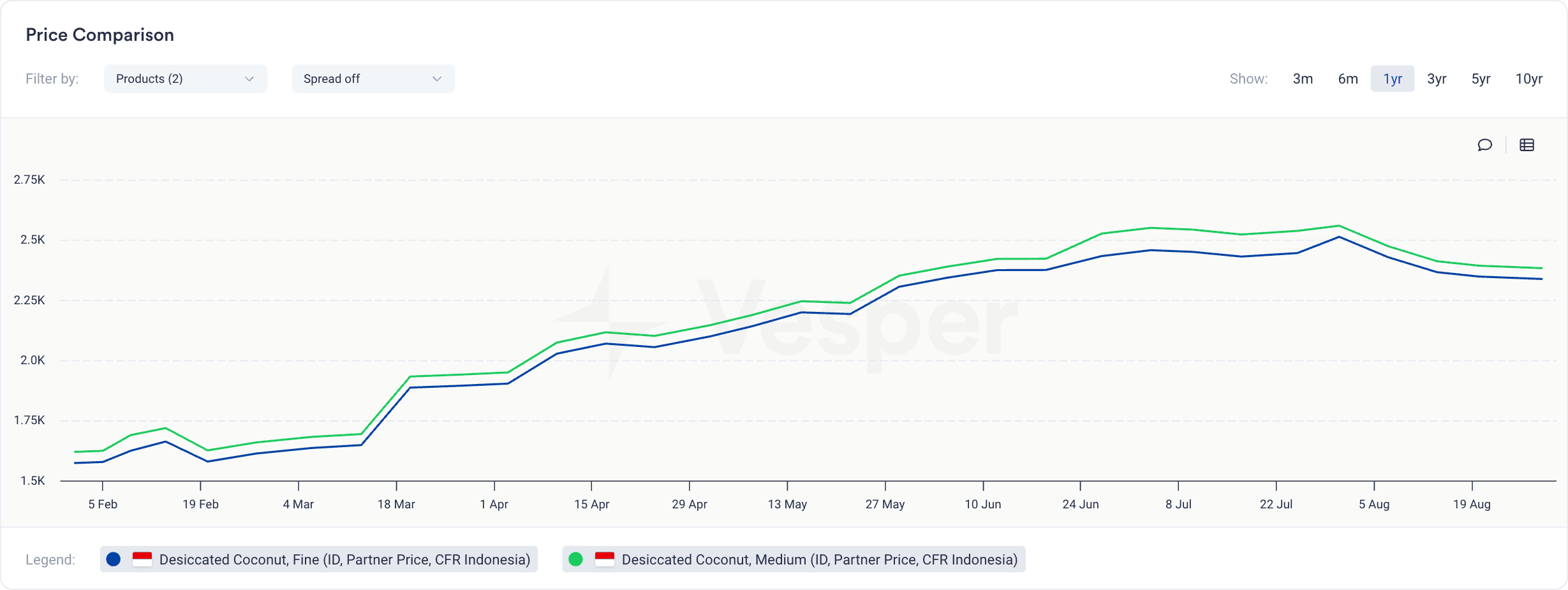- Desiccated Coconut, Fine (CFR Indonesia): Over the past year, prices for Desiccated Coconut, Fine have generally been higher than those for the Medium grade. Starting in early February 2023 at around $1,600 per metric ton, prices steadily increased, peaking at approximately $2,800 per metric ton in late July 2023 before slightly declining.
- Desiccated Coconut, Medium (CFR Indonesia): Prices for Desiccated Coconut, Medium followed a similar trend but remained consistently lower than the Fine grade. Beginning at approximately $1,500 per metric ton in early February 2023, prices also peaked in late July 2023, but at a slightly lower rate of around $2,750 per metric ton.
What Do These Differences Mean for Businesses?
Buyers
If you’re a buyer, understanding the price differences between Fine and Medium grades can help you decide which product to purchase based on your budget and quality requirements. For instance, a bakery that needs high-quality desiccated coconut for premium products might opt for the Fine grade, while another might choose the Medium grade to manage costs without compromising too much on quality.
Sellers
As a seller, knowing these pricing differences allows you to strategize your inventory and sales. If the Fine grade has a higher profit margin but slower turnover, you might balance your stock with the Medium grade to maintain cash flow and attract a broader customer base.
Frequently Asked Questions (FAQs) About Dried Fruit Price Comparisons
Why do prices for the same type of dried fruit vary so much?
Prices can vary due to differences in quality grades, supply chain costs, production expenses, and market demand. Higher quality grades often fetch higher prices, and costs associated with logistics and tariffs can further influence price variations.
How can I find the best prices for dried fruits?
To find the best prices for dried fruits, utilize commodity intelligence platforms like Vesper, which provide real-time data, trend analyses, and pricing forecasts specifically tailored to dried fruits. Government agricultural reports, such as those from the United States Department of Agriculture (USDA) and European Union Agricultural Markets Briefs, offer reliable data on production, pricing, and market trends. Additionally, trade associations and industry networks like the International Nut and Dried Fruit Council (INC) provide market insights, price updates, and networking opportunities that can help you access competitive pricing.
What factors should I consider when comparing dried fruit prices?
When comparing prices, consider the quality grade, source, production costs, seasonality, and any additional costs like shipping and tariffs. Understanding these elements will help you make more informed purchasing or selling decisions.
Are there seasonal trends in dried fruit prices?
Yes, prices for dried fruits often follow seasonal trends, influenced by harvest periods, climate conditions, and consumer demand cycles. For example, prices may rise during off-harvest seasons or holidays when demand spikes.
Example: Consider the price of dried apricots. The harvest season for fresh apricots typically occurs from May to August, and during this period, the supply of fresh apricots is high, which keeps the prices of both fresh and dried apricots relatively stable or lower. However, in the off-harvest months, particularly in winter, the supply of fresh apricots diminishes, leading to an increased demand for dried apricots. As a result, prices for dried apricots often rise during these off-season months and around the holiday season when they are commonly used in festive dishes and gift basket
